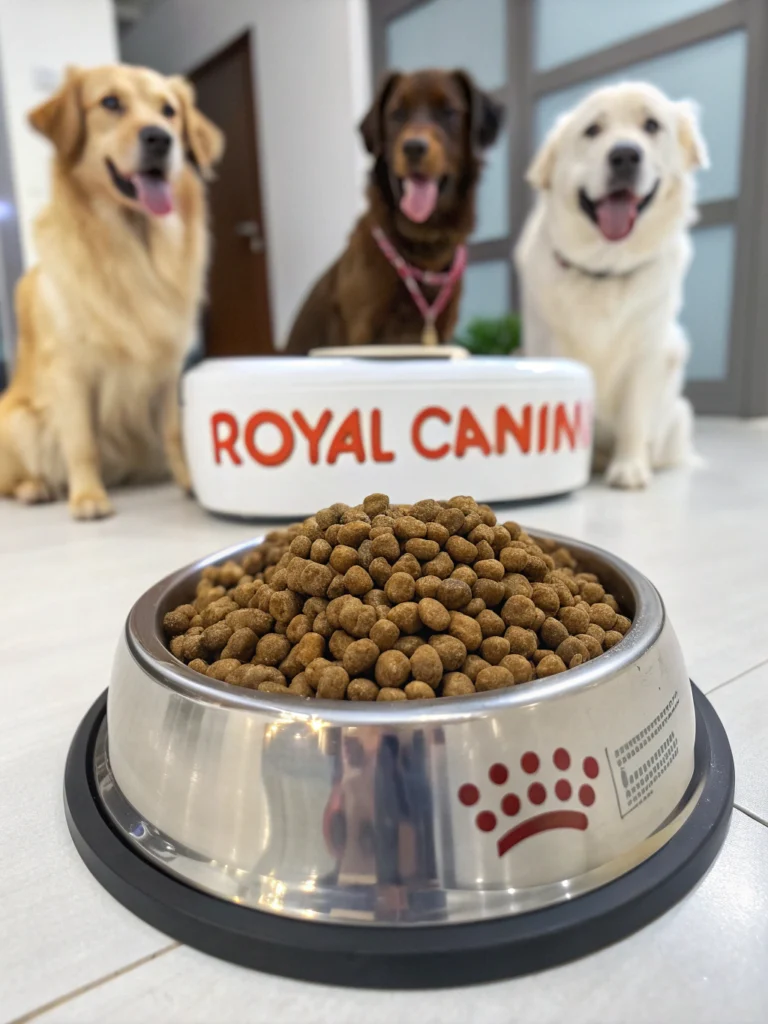Table of Contents
The health, happiness, and lifetime of your dog are all affected by your choice of dog food. Given the abundance of choices available, you may question whether Royal Canin is unique or whether it justifies the cost. Whether you are a first-time dog owner or a seasoned pet parent, knowing the advantages and disadvantages of Royal Canin will enable you to make an educated decision. So, how do the royal canin dog food reviews compare in 2025, and is this premium brand really the greatest option for your beloved buddy? Let’s explore a thorough investigation.
Key Ingredients in Royal Canin Dog Food
Product quality starts with ingredients. Royal Canin prides itself on science-backed formulations tailored to specific breed sizes, life stages, and health needs. Here’s what you typically find in Royal Canin dog food:
- High-Quality Proteins: Such as chicken or turkey meal, ensuring your dog gets ample amino acids for muscle development.
- Healthy Fats: Including fish oil or vegetable oils to support skin, coat, and joint health.
- Fiber Sources: Like psyllium husk or beet pulp, which aid digestion and promote gut health.
- Vitamins and Minerals: Essential for a balanced diet, often fortified at optimal levels for dogs.
For dogs with allergies or sensitivities, Royal Canin offers limited-ingredient and hydrolyzed protein options. Always check the label to align with your pup’s specific dietary requirements.
Preparation and Serving Timing
Feeding your dog Royal Canin doesn’t require any special preparation or cooking time. Simply:
- Measure the appropriate portion based on your dog’s weight and activity level.
- Serve dry or add warm water to soften kibble (especially beneficial for senior dogs).
- Allow your pup to enjoy their meal at their own pace.
On average, preparing a meal takes less than 5 minutes, making it a convenient choice for busy pet owners.
Step-by-Step Guide to Feeding Royal Canin
Feeding your dog isn’t rocket science, but knowing how to do it right can make a difference. Follow these simple steps:
Step 1: Identify Your Dog’s Needs
Royal Canin provides several different formulae. Choosing the appropriate one is the first step whether you want breed-specific kibble, senior food, puppy food, or a diet for diseases including renal illness.
Step 2: Transition Gradually
If switching from another food, gradually introduce Royal Canin over 7–10 days. Mix it with their old food, increasing the ratio slowly. This helps avoid digestive upset.
Step 3: Measure Appropriately
Follow the feeding instructions on the package; modify them depending on your dog’s energy level and body type. Preventing undernutrition or obesity depends on portion management.
Step 4: Serve at the Right Temperature
Although most dogs like room-temperature kibble, you may wet it with warm water for a softer texture, particularly good for pups or dogs with dental problems.
Step 5: Monitor and Adjust
Monitor your dog’s weight, coat condition, and energy levels. Change the serving amount or use a different Royal Canin recipe as required.
Nutritional Highlights of Royal Canin Dog Food
Royal Canin formulations are designed with specific nutritional targets in mind. Here’s what you can expect:
| Nutrient | Percentage/Amount | Benefit |
|---|---|---|
| Protein | 28% – 35% (varies by formula) | Supports muscle growth and repair. |
| Fats | 15% – 20% | Provides energy and supports coat health. |
| Fiber | 3% – 5% | Aids digestion and bowel health. |
| Key Ingredients | Breed-specific formulations | Tailor support for unique nutritional urgencies. |
Citing pet nutrition studies, Royal Canin often balances macro and micronutrients to meet the specific dietary demands of various dog breeds and life stages.

Pros and Cons of Royal Canin Dog Food
Every dog food brand has its strengths and weaknesses. Here’s a breakdown:
Pros:
- Science-Based Nutrition: Royal Canin is often recommended by vets due to its research-backed formulations.
- Specialized Formulas: Wide variety, including breed-specific, life-stage, and health-focused diets.
- High Palatability: Many dogs find Royal Canin appealing, which is crucial for picky eaters.
Cons:
- Higher Price Point: Compared to generic brands, Royal Canin can be costly.
- Some Reports of Digestive Issues: While generally well-tolerated, some dogs may experience sensitivity.
- Limited Grain-Free Options: Depending on the region, finding suitable grain-free formulas might be challenging.
For a deeper look, you can explore authoritative resources by visiting the Royal Canin pros and cons page.
Healthier Alternatives and Swaps
While Royal Canin is a top-tier brand, you might wonder about alternatives or ways to enhance their formulas. Here are some ideas:
- Boost with Fruits/Veggies: Small amounts of carrots, sweet potatoes, or pumpkin can add extra nutrients.
- Probiotic Supplements: Adding gut-friendly bacteria can improve digestion, especially for sensitive pups.
- Omega-3 Fatty Acids: Pouring a spoonful of fish oil can enhance coat and joint health if your dog needs extra support.
Always consult your vet before making significant dietary changes or adding supplements.
Creative Serving Suggestions
Making mealtime exciting can benefit your dog’s mental health. Here’s how to do it with Royal Canin:
- Use a Slow feeder Bowl: This not only makes eating a fun puzzle but also prevents rapid consumption.
- Freeze for Hot Days: Mix kibble with water in an ice cube tray and let your dog enjoy a cooling treat.
- Hide Treats in Toys: Stuff their kibble into a puzzle toy to encourage engagement during mealtime.
Common Feeding Mistakes to Avoid
Even the best food can be ineffective if fed incorrectly. Here are some pitfalls to avoid:
- Overfeeding: Stick to the recommended portion sizes and adjust for treats.
- Mixing Brands Too Quickly: Gradual transitions prevent digestive upsets.
- Free-Feeding: Leaving food out all day can lead to obesity or picky eating habits.
Always follow the feeding guidelines provided for Royal Canin formulas.
Storing Royal Canin Properly
Keeping your dog food fresh is essential for its nutritional value. Here’s how to store Royal Canin:
- Airtight Containers: Transfer opened bags to airtight containers to preserve freshness.
- Cool, Dry Place: Avoid humidity or direct sunlight, as these can degrade quality.
- Check Best-By Date: Even if unopened, ensure the batch hasn’t expired.
For opened bags, using a clip to reseal the top can prevent pests and maintain freshness.
Conclusion: Is Royal Canin Worth It?
Royal Canin distinguishes itself among luxury dog food for its scientific approach and particularity. Many dog owners believe the increased health results and customized recipes warrant the expenditure even if the price is more than other brands. Your dog’s needs, your budget, and your veterinarian’s advice will finally determine the ideal diet for them. Why not look at royal canin dog food reviews to identify a recipe that fits your hairy family member?
Ready to make an informed choice? Dive deeper into dog nutrition with our comprehensive guide, or share your own experiences with Royal Canin in the comments below!
FAQs
Q: Is Royal Canin good for all dogs?
A: While Royal Canin is highly regarded, its best for dogs with specific needs or breeds since its formulated to address particular health and life stage requirements.
Q: How much does Royal Canin cost compared to other brands?
A: Royal Canin is typically at the higher end of the price spectrum, reflecting its specialization and nutritional quality. On average, expect to pay 20–30% more than standard grocery store brands.
Q: Are there any grain-free Royal Canin options?
A: Royal Canin does offer some grain-free formulas, though selections may vary by region. Always check the retailer or manufacturer’s website for the latest options.
Q: Can puppies eat Royal Canin?
A: Yes, Royal Canin offers puppy-specific formulas tailored to growth and development needs. Just ensure you’re selecting the appropriate stage of puppyhood.
Q: What are the main differences between Royal Canin and other premium brands like Orijen or Blue Buffalo?
A: Royal Canin focuses more on specialized health and breed needs, while brands like Orijen emphasize high-meat-content, biologically appropriate diets. Blue Buffalo often highlights natural ingredients and holistic support. The choice depends on whether you prioritize specificity (Royal Canin) or general high-quality ingredients (others).
Choosing the right pet food can feel overwhelming, but with the right information, you’ll be well-equipped to make the best decision for your furry friend!



